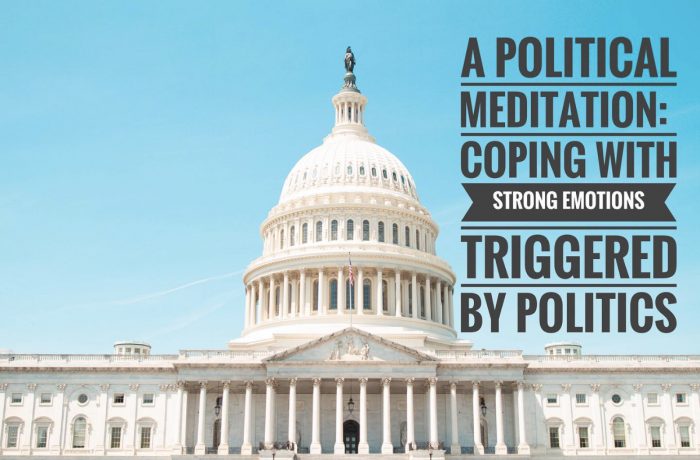“United we stand, divided we fall.” ~ Aesop
~
Here we are in another tumultuous election year.
If you follow politics, and even if you don’t, the geopolitical constructs today elicit strong emotions in all people across the spectrum.
I almost never write about or discuss politics—I am, in my old age, more concerned with the teachings of empathy and compassion, but my aim today in this valued and worthy discussion is to provide a tool so we don’t have a repeat of the last few years, or worse, continue on the path we are currently on.
I have friends who have abandoned all in the fight for their cause. I once was proud to be an activist, and marched with my pointer finger shaking in faces; I chained myself to trees and I exhaled smoke in Tommy Thompson’s face. But what I realize now is that it was naïve and quite adolescent despite my young adult age. It was without wisdom, reactionary, ridiculous, embarrassing, and often harmful. It was without stillness. It was aggressive and completely lacking in empathy.
It was an “I’m right, and you are wrong! And I’m not budging,” mentality.
This is not the way.
And thankfully today, I consider myself a reformed and recovered political enthusiast. Still human, and unhinged at times, but more often than not, just concerned about the well-being of others who stand dutifully in the ring.
I have friends on both sides of the political spectrum and what I see is distressing. It is not constructive, and it is causing harm. It is dividing neighbors, friends, and families.
The drastic paradigm shifts are just making us seasick.
How will we ever unite? When will we begin to see that more divisiveness, more yelling, more anger is not the answer? Anger is never the answer. It might be the spark, the ignition, but it is never the solution. It is not meant to be a permanent archetype or trait characteristic. It is frenzied, and although it might feel clear-headed and in control, it is the wolf in sheep’s clothing. The science of holding anger in the body is astounding, depicting repeatedly how it negatively affects our health, our happiness, and our well-being. We cannot see clearly when we are stuck in activated and engaged anger—it is basic neuroscience.
The research it draws on is what they call “limbic hijacking.” This is when our emotions get the best of us. They take over and we are in a continuous state of overreaction.
Although some of the time our anger is warranted, most of the time it is disproportional to the actual event happening. Like having a poolside conversation with a neighborhood friend about the education system, it becomes politically edgy and before you know it, results in a complete shutdown, severance of the relationship, and with one full guillotine motion, we are done, finished, never to speak again, or at least until the other apologizes first or sees things my way. Right?!
I recently learned about a study on a podcast with Jeff Warren, a meditation teacher and author, that looked at the brains of both liberals and conservatives.
What I learned was that while each was listening to the other, in both sides, the red and the blue, their emotional brains lit up like an “old-fashioned telephone switchboard.”
What this means is that when the amygdala and the limbic system are all highly stimulated, there is a drop in IQ, and there is a decrease in our capacity to reason and problem-solve. Both lids are flipped, meaning the staircase connecting the limbic system to the prefrontal cortex, where wisdom and reasoning are headquartered, has been disconnected. Like a staircase in Hogwarts castle, it has changed route, only nothing magical is happening here—it is essentially leaving you stranded and perhaps overcome with fear or anger or some other paralyzing, strong emotion. Both individuals are now stuck in an activated threat response.
Can you see how ineffective this might be? You are defending yourself from me, and I am defending myself from you. No amount of anger or shouting is going to disengage this threat response; in fact quite the contrary, it is overheating the engine.
In other words, when liberals and conservatives interact, it is often the case that neither one is being rational, there is no real conversation, it is just two monologic diatribes muttering at each other, which is actually part of what has gotten us into this incredible polarization and divisiveness. We cannot “feel” into the other with empathic concern, when we are in our own threat response of defensiveness. In fact, we cannot even “feel” into our own selves. We are, in that moment, quite literally disconnected from our own bodies.
Try this: the next time you are fully enraged in the heat of a moment, see if you can simultaneously wiggle your toes and feel your feet. It’s not likely. And, if you do feel into your toes, then congratulations, you have just interrupted the rage, paused, and have the ability to now put your lid back on.
The antidote to soothe this over-activated threat response is safety, by the way.
Safety can be ensured when we have clarity of mind, stability within ourselves, and stillness. When we can acquire all three of these qualities, we can see the situation through a more realistic lens. Meaning, this is merely a conversation with another person. Not an actual threat. You are most likely not having this conversation on the Savannah all the while being chased by a wild pack of hyenas. They are human, just like you. And just like you, they too have strong, political values.
Pause, remember your training, take a breath, track your emotions, put your lid back on, and calm your own nervous system. This will not come automatically, but it is teachable, trainable, and completely do-able. Instilling a compassionate meditation practice builds safety and security first in our own selves, and then like ripples in a pond, effects positive change to those around us. This is the beginning step of altruistic empathy and helping to keep our United States united.
A true and clear understanding of walking in someone else’s shoes is necessary, and perhaps mandatory. A heart-opening and oftentimes a heartbreaking realization of someone else’s life and how they gained their strong, opinionated sense of political values. If we go back far enough into our own self-inquiry, we can see that our path is quite predictable. Our arguing, our righteousness, our political staunchness, has been blue-printed in, either through our parents, or our life experiences, or a complete defiant reaction to either of those. There was, perhaps, no other way. You turned out the way you did. And that is okay. But can we also see that this is likely the same for the other person? How very human.
With an open curiosity and a stillness from within, trust can rebuild and safety can cultivate.
If you believe in change via persuasion, then the rudimentary and fundamental concept is this: persuasion requires understanding, and understanding requires clarity, and clarity requires wisdom, and wisdom requires stillness.
To create change, we have to help the “other side” understand us, and we need to understand them. And eventually, we work toward a bigger goal of dissolving the “us” and “them” categories.
Even though we claim to be “peacefully marching,” or “peacefully protesting,” we are not still. We are full of rage, anger, hatred, contempt, righteousness, fear, and basically a maelstrom of emotions that are not still or calm. It’s a fury out there and in here (inside the self). Think: eye of a hurricane. How can we obtain that level of stillness even in the political storms?
In a free guided meditation I’ve included below, I hope to illuminate ways for us to navigate the upcoming election year and to find stillness, even amidst the storm, no matter where on the spectrum you fall.
Its intention is to find perspective, not lose our heads, and maintain our dignity in the strong current of emotions that politics today is notoriously known to evoke. It is here in the hopes that it helps you take care of yourself during those heated times when you feel triggered.
What to expect:
In this meditation, we are engaging in a called-upon specific trigger that evokes strong emotions. It is asking us to engage with something that might be difficult.
Why would we want to purposely induce such suffering by allowing a strong emotion?
What you will learn is that by allowing the emotion, we allow ourselves not be triggered by it; we can constructively learn to work with it, understand it, see what it is doing within our body, and learn to unhook from the intensity of it—and in doing so, it helps us act more sanely.
If we practice in the gym, then we are stronger in our actual lives. This meditation is meant to be used as a training ground, a practice in learning to slow down the process of being triggered. This type of emotional engagement and body awareness helps to build our emotional intelligence and increase our literacy of where we feel our reactions. This practice of self-inquiry teaches us where we hold certain emotions, and we can then see how they influence us, what message they bring, and if we need to react, respond, or just validate them through self-soothing, acknowledging that nothing is required in this moment.
We essentially learn to pause. And then we have a choice to respond.
Of course, when the rubber meets the road, we are triggered, and boom, we are not going to have time to slow down and do a meditation. But in that critical moment, we can pause, and put our lid back on, and put these skills into play. Right there, in the midst of the trigger. This awareness will change everything.
The point of this meditation practice is to learn the technique so that when we are politically jarred, and all of this stuff starts coming up, and our emotional reactions are triggered, we can choose to act differently.
This is not a meditation aimed at delivering absolute peace. You are going to get triggered politically and otherwise in your daily lives. As you live your life, use this meditative technique as a way to hold on to yourself, hold on to your center, be the eye of the hurricane. Not freak out, flip your lid, and lose more friends, neighbors, and family. We can instead be clear in our center, and from that place, respond more effectively.
This is the point here. It is not about suppressing how we feel, or turning into some sort of Pollyanna, easy-going, doormat chump. It is the opposite of that.
It is about compassionately caring so much about the situation that you are going to let your best human qualities emerge.
It is about learning how to see, validate, and connect to our triggered emotions, feeling them fully and letting them expansively play out within a much larger field. We can cultivate a truer vision that is more in line with our reality. One that wants us to stay connected to people, even to those who irritate us.
Enjoy this meditation. This is a nonpartisan practice, open to all.












Read 0 comments and reply